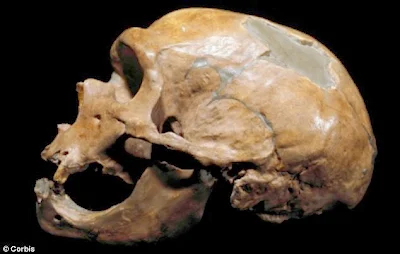Η
μαύρη τρύπα στο κέντρο του γαλαξία μας εκτοξεύει δέσμες αερίων έξω από αυτόν. New
evidence has been uncovered for the presence of a jet of high-energy particles
blasting out of the Milky Way's supermassive black hole. As outlined in the
press release, astronomers have made the best case yet that such a jet exists
by combining X-ray data from NASA's Chandra X-ray Observatory with radio
emission from the NSF's Very Large Array (VLA). This composite image features
both X-rays from Chandra (purple) and radio data from the VLA (blue). A labeled
version of this image - seen by mousing over the image - reveals the position
of Sagittarius A* (Sgr A* for short) and the suspected jet. The location of a
shock front is also marked. As the jet fires away from Sgr A*, it travels
through space until it hits gas several light years away. (The region around
the Milky Way's black hole has many clumps of gas and dust.) Once the jet hits,
it triggers the formation of a shock front. This interaction also accelerates
electrons, generating X-rays as the electrons stream down the path of the jet,
past the shock front. The shock front is also of interest because it is
unusually wide in the radio emission compared to the more narrow profile of the
jet in X-rays. This suggests that there may be a secondary, weaker outflow,
which might be like a sheath or cocoon surrounding the jet with an opening
angle of around 25 degrees. Sgr A* is about 4 million times the mass of the Sun
and lies about 26,000 light years from Earth in the center of the Galaxy.
Astronomers have been looking for a jet from Sgr A* for years since it is now
common to find jets tied to a range of cosmic objects on both big and small
scales. Prior to this latest study, there have been reports of possible
evidence of a jet associated with Sgr A*. However, these have contradicted one
another and have thus not been considered definitive. Credit: X-ray:
NASA/CXC/UCLA/Z.Li et al; Radio: NRAO/VLA
Μια
φωτογραφία ενός εντυπωσιακού κοσμικού φαινομένου έδωσε στη δημοσιότητα η
NASA. Σε αυτή διακρίνονται δέσμες αερίων
που αποτελούνται από υψηλής ενέργειας σωματίδια να βγαίνουν με μεγάλη ταχύτητα
έξω από τον γαλαξία μας. Πρόκειται για αέρια που εκτοξεύονται σαν πίδακες που
πηγάζουν από κάποιο κοσμικό συντριβάνι. Στην πραγματικότητα τα αέρια
εκτοξεύονται από τον Τοξότη Α*, την γιγάντια μελανή οπή στο κέντρο του Γαλαξία.
Η
φωτογραφία των αερίων που εγκαταλείπουν τον γαλαξία μας αποτελεί σύνθεση
εικόνων που έχουν καταγράψει το διαστημικό τηλεσκόπιο Chandra και η συστοιχία
ραδιοτηλεσκοπίων VLA στο Νέο Μεξικό στις ΗΠΑ.
Πριν
από λίγο καιρό οι επιστήμονες ανακάλυψαν ότι ο Τοξότης Α* δεν «καταβροχθίζει»
υλικά με τον ρυθμό που θα αναμενόταν αλλά αντιθέτως τα «φτύνει» εκτοξεύοντάς
τα, μάλλον επειδή είναι πολύ καυτά. Η ανακάλυψη, η οποία εξηγεί γιατί η «δική
μας» μαύρη τρύπα έχει τόσο χαμηλή ακτινοβολία σε σχέση με άλλες, αποτελεί ένα
σημαντικό βήμα για την κατανόηση των μελανών οπών από τους επιστήμονες.
Υποδηλώνει επίσης ότι ίσως αυτή η συμπεριφορά του Τοξότη Α* εμποδίζει τη
γέννηση νέων άστρων στο κέντρο του Γαλαξία.































